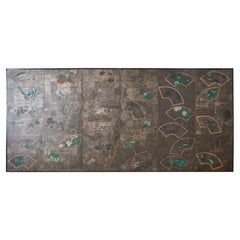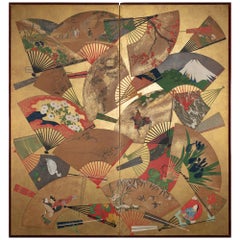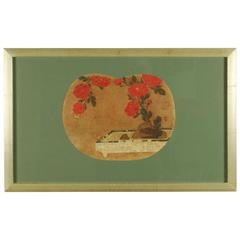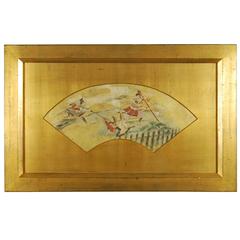Japanese Screen Of Fans
to
3
3
3
2
1
1
Sort By
18th Century Japanese Two-Panel Screen Collection of Fans on Gold
Located in Hudson, NY
18th century Japanese Screen of a Collection of Fans. Paintings on fans depict famous Japanese
Category
Antique 18th Century Japanese Edo Paintings and Screens
Materials
Gold Leaf
Japanese Six Panel Meiji Screen of Scattered Fans
Located in Rio Vista, CA
Large scale dramatic Japanese late 19th-early 20th century Meiji screen depicting numerous
Category
Antique 19th Century Japanese Meiji Paintings and Screens
Materials
Brass, Silver Leaf
Japanese Two-Panel Screen Rimpa Painting of Fans on Gold
Located in Hudson, NY
Japanese two-panel screen: Rimpa painting of fans on gold. A beautifully painted Edo period (early
Category
Antique Early 19th Century Japanese Edo Paintings and Screens
Materials
Gold Leaf
Antique Japanese Fan Painting of Chrysanthemum Bonsai, Edo Period
Located in Prahran, Victoria
Japanese fan painting depicting a red chrysanthemum bonsai in bloom, with artists ink seals, Mid
Category
Antique 18th Century Japanese Edo Paintings and Screens
Materials
Paper
$750
H 17.33 in W 27.96 in D 1.19 in
Antique Japanese Fan Painting with Scenes of a Samurai Battle
Located in Prahran, Victoria
Delicately painted Japanese fan painting with a depiction of samurai warriors engaged in battle
Category
Antique Late 18th Century Japanese Edo Paintings and Screens
Materials
Paper
Get Updated with New Arrivals
Save "Japanese Screen Of Fans", and we’ll notify you when there are new listings in this category.
Japanese Screen Of Fans For Sale on 1stDibs
There is a range of Japanese screen of fans for sale on 1stDibs. Frequently made of wood, fabric and paper, all Japanese screen of fans available were constructed with great care. There are 27 antique and vintage Japanese screen of fans for sale at 1stDibs, while we also have 5 modern editions to choose from as well. Japanese screen of fans have been produced for many years, with earlier versions available from the 18th Century and newer variations made as recently as the 21st Century. Japanese screen of fans bearing mid-century modern or Art Deco hallmarks are very popular at 1stDibs. Japanese screen of fans have been a part of the life’s work for many furniture makers, but those produced by Cassina, Hidaka Tetsuo and Charlotte Perriand are consistently popular.
How Much are Japanese Screen Of Fans?
Prices for Japanese screen of fans can differ depending upon size, time period and other attributes — at 1stDibs, Japanese screen of fans begin at $45 and can go as high as $65,000, while the average can fetch as much as $2,981.
Questions About Japanese Screen Of Fans
- What are Japanese fans called?1 Answer1stDibs ExpertApril 5, 2022A folding fan from Japan is called a “sensu” or “o-gi” while a non-folding fan is called an “uchiwa.” Both styles of hand fans were used as a material to write and communicate through as well as showcase social status. Browse a selection of authentic Japanese fans on 1stDibs.
- 1stDibs ExpertAugust 17, 2021Japanese screens are called Byōbu and are made from many panels with beautiful calligraphy and paintings. These folding screens can be a decorative and interesting way to separate rooms in a living space. Find a collection of Japanese screens for sale on 1stDibs.
- 1stDibs ExpertApril 5, 2022There are three types of Japanese fans. The uchiwa is a fixed fan that is used practically to create a breeze and stay cool. The sensu or ogi fan is a folding fan that is a fashion accessory as well as cooling the user. The gunsen fan is a war fan that was used during war times for signaling and also occasionally as a weapon. Shop an array of authentic Japanese fans on 1stDibs.
- 1stDibs ExpertApril 5, 2022Japanese screen painting is the art of creating byōbu, or Japanese screens. Byōbu vary in subject matter and style. The screens are free-standing, portable and decorated with symbolic images or calligraphy. It is common to find byōbu in pairs with at least two panels. Shop a selection of byōbu on 1stDibs.
 Lotus GalleryMarch 17, 2021A Japanese low screen was traditionally used while seated upon the floor. The low screen would block wind and drafts, provide limited privacy, and are often decorated with seasonal themes.
Lotus GalleryMarch 17, 2021A Japanese low screen was traditionally used while seated upon the floor. The low screen would block wind and drafts, provide limited privacy, and are often decorated with seasonal themes.
More Ways To Browse
Galliano Butterfly
Japanese Empress Doll
Nursery Screen
Silk Embroidered Byobu
Folding Opera Glasses Vintage
Geisha Silk Painting
Theda Bara
Floor Speakers Vintage
Japanese Flower Cart Screen
Japanese Folding Screen Rice Paper
Beatles Japan
Eileen Gray For Jumo
Japanese Screen Holder
Dior Koi
George Jay Rogers
Soleil Table Lamp
Sakai Hoitsu
Seizo Sugawara




